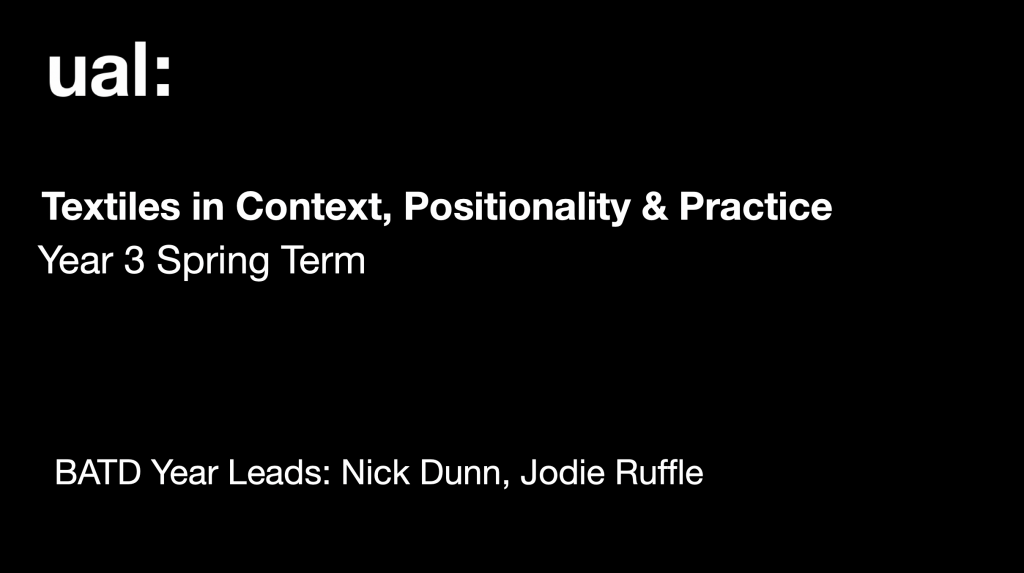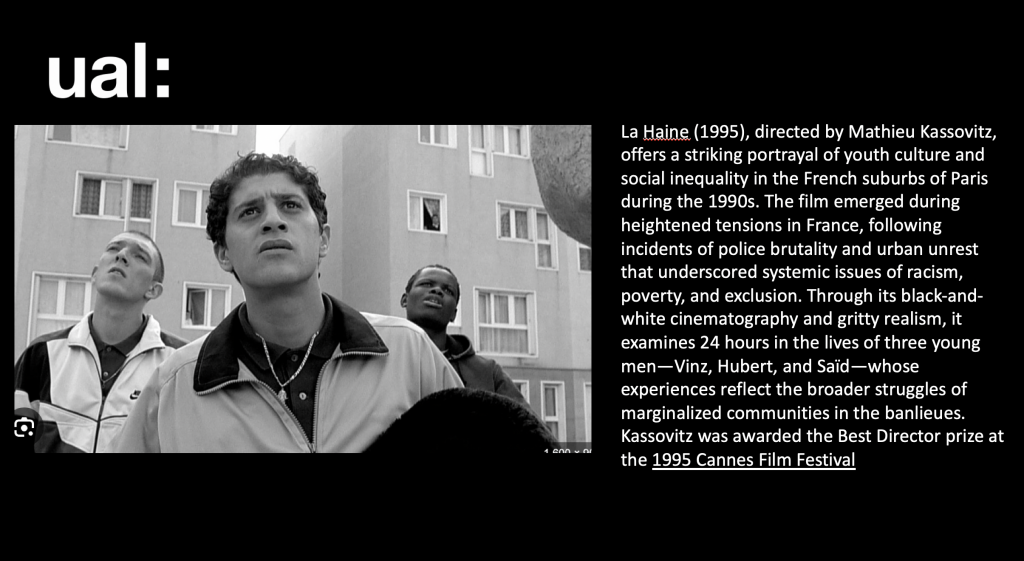‘
“There is no such thing as a single-issue struggle because we do not live single struggle lives”
Audre Lorde, ,1984

For my A.R.P Activity i created a session titled Positionality & Practice. A 3 hour group discussion with BA Textile Design Year 3 students. Jodie Ruffle (BATDY3 leader) and i kicked the session off with a short presentation (45mins) about our own historical positionality when we were undergraduates, and in hindsight how these identities reflected in our work/career trajectory.
We asked the students to think of a piece of work that they felt aligns with how they perceived their identity through the following mediums.
- Piece of music or musical genre or a particular musician.
- A film/genre or a particular director/ cinematographer
- A book/genre or a particular author
- Textile, artist, practitioner, fashion designer, label, brand
- An environment, neighborhood, place or community
Students were asked to take note and consider the above points in order to aid our informal discussions. We as academics also used these mediums to present our own historical positionality in order to encourage and promote a ‘non-hierarchical environment’ for which we could start an open discussion exploring positionality in relation to their practice.

Above is a slide i used as an example of my historical positioning through the cult 90’s French film La Haine.
The group discussion was delivered as part of a series of sessions we’ve been doing with BATDY3 titled ‘Textiles in Context’ where we have open informal discussions formed around relative topics/aspects of their future practice within the industry.
The key characteristics or learning outcomes desired were as follows.
- – Practice being self-aware, reflecting on the world around us, our own biases and positionality
- – Recognizing and responding to the differences and synergies of positionality stand points within the room.
- – Start to entertain the notion of positionality being utilized and referenced in practice
The workshop took a decentred approach by:
- – Acknowledge multiple ways of knowing, and the value of difference
- – Non hierarchical approach – students and staff were both learners and educators
- – Students voices are central to the discussion and direction of the discussion.
In the last ten minutes of the session we asked the students to anonymously fill out a Critical Incident Questionnaire (CIQ) .The questions asked were as follows.
- At what moment in today’s session did you feel most engaged with what was happening?
- At what moment in today’s session were you most distanced from what was happening?
- What action that anyone (teacher or student) took today did you find most affirming or helpful?
- What action that anyone took today did you find most puzzling or confusing?
- What about the class today surprised you the most? (This could be about your own reactions to what went on, something that someone did, or anything else that occurs).
- Do you think making space for sessions like this would be beneficial for your ongoing work ? If your answers yes, why ?
Reflection on the session
Myself and Jodie were really pleased in our immediate reflection on the session, especially with the group discussion as we felt there was a very natural fluidity to the conversation between ourselves and the students who attended (10 attendees including us).
Learning from the trail run positionality workshop i did with Jason Forest we added the 45min historical positioning presentation which we felt quickly established an inclusive non hierarchical environment of knowledge exchange so the students in turn felt it was a safe space and were vocally forthcoming with sharing their thoughts and opinions on the topic.
Bibliography
Audre Lorde, Sister Outsider, Crossing Press, 1984
https://www.stephenbrookfield.com/critical-incident-questionnaire